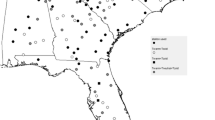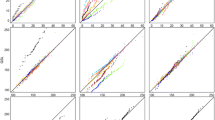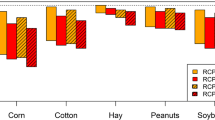Abstract
An investigation is made of the possible impacts of a climatic change (induced by a doubling of atmospheric carbon dioxide concentration) on the European agricultural sector. Two general circulation models have been used to develop climatic change scenarios for the European study area. From the scenarios, information was obtained concerning the possible behavior of temperature, precipitation, solar radiation, and relative humidity in the altered climatic state. This meteorological information was then employed in two separate crop-weather models - an empirical/statistical model (for winter wheat) and a simple simulation model (for biomass potential). This type of approach represents a considerable departure from that employed by previous large-scale climate impact studies. Both the seasonal and regional components of a possible climatic change are incorporated directly in the two crop-weather models. The results of this investigation demonstrate that a simple crop-weather simulation model may be more suitable for the purposes of agricultural impact analysis than the linear regression models frequently used in such studies. In order for such an impact analysis to be accepted as a valid scientific experiment, a full presentation of the underlying assumptions and uncertainties is essential.
Similar content being viewed by others
References
Bach, W., Jung, H.J., and Knottenberg, H.: 1984, ‘Development of Regional Climate Scenarios’, in Meinl et al. (1984).
Briggs, D.J.: 1983, ‘Biomass Potential of the European Community’, Report for the Environment and Consumer Protection Service of the European Community, Sheffield, U.K.
Bryan, K., Komro, R.G., Manabe, S., and Spelman, M.J.: 1982, ‘Transient Climate Response to Increasing Carbon Dioxide’, Science 215, 56–58.
Corby, G.A., Gilchrist, A., and Rowntree, P.R.: 1977, ‘United Kingdom Meteorological Office Five Level General Circulation Model’, Methods in Computational Physics Vol. 17, pp. 67–110, Academic Press, New York.
Flohn, H.: 1980, ‘Possible Climatic Consequences of a Man-Made Global Warming’, Research Report RR-80–30, International Institute for Applied Systems Analysis, Laxenburg, Austria.
Gates, W.L.: 1984, ‘The Use of General Circulation Models in the Analysis of the Ecosystem Impacts of-Climatic Change’ (submitted to Climatic Change).
Haigh, P.A.: 1977, ‘Separating the Effects of Weather and Management on Crop Production’, C.F. Kettering Foundation, ST 77-4.
Hansen, J., Lacis, A, Rind, D., Russell, G., Stone, P., Fung, I., Ruedy, R., and Lerner, J.: 1984, ‘Climate Sensitivity: Analysis of Feedback Mechanisms’, in J. Hansen and R. Takahasi (eds.), Climate Processes and Climate Sensitivity, Maurice Ewing Series 5, American Geophysical Union, Washington, D.C.
Hansen, J., Russell, G., Rind, P., Stone, P., Lacis, A, Lebedeff, S., Ruedy, R., andTravis, L.: 1983, ‘Efficient Three-Dimensional Global Models for Climate Studies: Models I and II’, Monthly Weather Review 110, 609–862.
Hanus, H.: 1978, ‘Forecasting of Crop Yields from Meteorological Data in the EC Countries’, Agricultural Statistical Studies, No. 21, Statistical Office of the European. Communities.
Hunt, B.G.: 1981, ‘An Examination of Some Feedback Mechanisms in the Carbon Dioxide Climate Problem’, Tellus 33, 78–88.
Jäger, L.: 1976, ‘Monatskarten des Niederschlags fur die ganze Erde’, Berichte des Deutschen Wetterdienstes, No. 139.
Katz, R.W.: 1979, ‘Sensitivity Analysis of Statistical Crop-Weather Models’, Agric. Meteorol, 20, 291–300.
Kellogg, W.W.: 1983, ‘Regional Scenarios of Future Climate Change’, Paper prepared for the International Federation of Institutes for Advanced Study (IFIAS), Program on Analyzing Biospheric Changes (ABC).
Kellogg, W.W. and Schware, R.: 1981, Climate Change and Society, Westview Press, Boulder, Colorado.
Kim, J.W., Chang, J.T., Baker, N.L., Gates, W.L., and Wilks, D.J.: 1984, ‘The Statistical. Problem of Climate Inversion: Determination of the Relationship Between Local and Large-Scale Climate’, Monthly Weather Review (in press).
Lemon, E.R.: 1963, CO 2 and Plants, The Response of Plants to Rising Levels of Atmospheric Carbon Dioxide, Westview Press, Boulder, Colorado.
Lough, J.M., Wigley, T.M.L., and Palutikof, J.P.: 1983, ‘Climate and Climatic Impact Scenarios for a Warmer World’, J. Clim. Appl. Meteorol, 22, 1673–1684.
Meinl, H., Bach, W., Jäger, J., Jung, H.-J., Knottenberg, H.,. Marr, G., Santer, B.D., and Schwieren, G.: 1984, ‘The Socio-Economic Impacts of Climatic Changes due to a Doubling of Atmospheric CO2 Content’, Report to CEC, Brussels, Contract No. CLI-063D, and DFVLR, Cologne, Contract No. V30501-0004/81.
Mitchell, J.F.B.: 1983, ‘The Seasonal Response of a General Circulation Model to Changes in CO2 and Sea Surface Temperature’, Q. J, Roy. Meteorol. Sac, 109, 113–152.
Müller, M.J.: 1982, Selected Climatic Data for a Global Set of Standard Stations for Vegetation Science, Dr. W. Junk Publishers, The Hague, Netherlands.
National Academy of Sciences: 1983, ‘Changing Climate’, Report of the Carbon Dioxide Assessment Committee, National Academy Press, Washington, D.C.
National Defense University: 1980, Crop Yields and Climate Change to the Year 2000, Vol. 1, Fort Lesley J. McNair, Washington, D.C.
Palutikof, J.P., Wigley, T.M.L., and Farmer, G.: 1984, ‘The Impact of CO2-Induced Climatic Change on Crop Yields in England and Wales’, Prog. Biometeor. 3, 320–334.
Pittock, A.B. and Salinger, M.J.: 1982, ‘Towards Regional Scenarios for a CO2-Warmed Earth’, Climatic Change 4, 23–40.
Reed, D.N.: 1984, ‘Model Simulation of Temperature and Precipitation in a Single Grid Box in a Multi-Annual Integration of a General Circulation Model’, Met. Office Technical Note No. II/197, Bracknell, U.K.
Rowntree, P.R.: 1978, ‘Means and Standard Deviations for 5-Layer Model Simulations’, Met. Office Technical Note No. II/118, Bracknell, U.K.
Santer, B.D.: 1984, ‘The Impacts of a CO2-lnduced Climatic Change on the European Agricultural Sector - A Case Study’, in Meinl et al. (1984).
Schirmer, H.: 1977, ‘Langjährige Monatsund Jahresmittel der Lufttemperatur und Niederschlags in der B.R.D. für die Periode 1931–1960’, itBerichte des Deutschen Wetterdienstes, No. 115.
Schlesinger, M.E.: 1983, ‘Simulating CO2-lnduced Climatic Change with Mathematical Models: Capabilities, Limitations and Prospects’, in Proceedings of CO 2 Research Conference: Berkeley Springs, West Virginia, September 19–23, 1982, pp. III.3-III. 139.
Schlesinger, M.E.: 1984a, ‘Atmospheric General Circulation Model Simulations of the Modern Antarctic Climate’, in Environment of West Antarctica: Potential CO 2-lnduced Change, National Academy Press, Washington, D.C., pp. 155–196.
Schlesinger, M.E.: 1984b, ‘Climate Model Simulations of CO2-Induced Climatic Change’, in B. Saltzman (ed), Advances in Geophysics Vol. 26, pp. 141–235, Academic Press, New York.
Schutz, C. and Gates, W.L.: 1971, ‘Global. Climatic Data for Surface, 800mb, 400mb: January’, Report No. R-915-ARPA, The Rand Corporation, Santa Monica, California.
Schutz, C. andGates, W.L.: 1972, ‘Global Climatic Data for Surface, 800mb, 400mb: July’, Report No. R-1029-ARPA, The Rand Corporation, Santa Monica, California.
Statistical Office of the European Community: 1980, ‘Land Use and Production, 1955–1979’, Eurostat.
Thompson, S.L. and Schneider, S.H.: 1982, ‘Carbon Dioxide and Climate: The Importance of Realistic Geography in Estimating the Transient Temperature Response’, Science 217, 1031–1033.
U.S. Department of Transportation: 1975, ‘Impacts of Climatic Change on the Biosphere - Climatic Effects’, Climatic Impact Assessment Program Monograph 5, Part 2, Washington, D.C.
Wigley, T.M.L., Ingram., M.J., and Farmer, G.: 1981, Climate and History, Cambridge University Press, London.
Author information
Authors and Affiliations
Rights and permissions
About this article
Cite this article
Santer, B. The use of general circulation models in climate impact analysis — A preliminary study of the impacts of a CO2- induced climatic change on West European agriculture. Climatic Change 7, 71–93 (1985). https://doi.org/10.1007/BF00139442
Issue Date:
DOI: https://doi.org/10.1007/BF00139442




